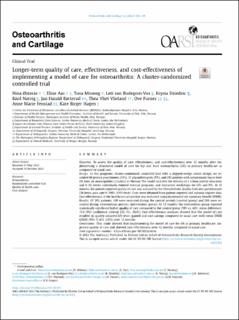| dc.contributor.author | Østerås, Nina | |
| dc.contributor.author | Aas, Eline | |
| dc.contributor.author | Moseng, Tuva | |
| dc.contributor.author | van Bodegom-Vos, Leti | |
| dc.contributor.author | Dziedzic, Krysia | |
| dc.contributor.author | Natvig, Bård | |
| dc.contributor.author | Røtterud, Jan H | |
| dc.contributor.author | Vlieland, Thea Vliet | |
| dc.contributor.author | Furnes, Ove Nord | |
| dc.contributor.author | Fenstad, Anne Marie | |
| dc.contributor.author | Hagen, Kåre Birger | |
| dc.date.accessioned | 2024-04-18T12:32:26Z | |
| dc.date.available | 2024-04-18T12:32:26Z | |
| dc.date.created | 2023-11-14T13:11:22Z | |
| dc.date.issued | 2024 | |
| dc.identifier.issn | 1063-4584 | |
| dc.identifier.uri | https://hdl.handle.net/11250/3127292 | |
| dc.description.abstract | Objective: To assess the quality of care, effectiveness, and cost-effectiveness over 12 months after implementing a structured model of care for hip and knee osteoarthritis (OA) in primary healthcare as compared to usual care.
Design: In this pragmatic cluster-randomized, controlled trial with a stepped-wedge cohort design, we recruited 40 general practitioners (GPs), 37 physiotherapists (PTs), and 393 patients with symptomatic hip or knee OA from six municipalities (clusters) in Norway. The model included the delivery of a 3-hour patient education and 8–12 weeks individually tailored exercise programs, and interactive workshops for GPs and PTs. At 12 months, the patient-reported quality of care was assessed by the OsteoArthritis Quality Indicator questionnaire (16 items, pass rate 0–100%, 100%=best). Costs were obtained from patient-reported and national register data. Cost-effectiveness at the healthcare perspective was evaluated using incremental net monetary benefit (INMB).
Results: Of 393 patients, 109 were recruited during the control periods (control group) and 284 were recruited during interventions periods (intervention group). At 12 months the intervention group reported statistically significant higher quality of care compared to the control group (59% vs. 40%; mean difference: 17.6 (95% confidence interval [CI] 11.1, 24.0)). Cost-effectiveness analyses showed that the model of care resulted in quality-adjusted life-years gained and cost-savings compared to usual care with mean INMB €2020 (95% CI 611, 3492) over 12 months.
Conclusions: This study showed that implementing the model of care for OA in primary healthcare, improved quality of care and showed cost-effectiveness over 12 months compared to usual care. | en_US |
| dc.language.iso | eng | en_US |
| dc.publisher | Elsevier | en_US |
| dc.rights | Attribution-NonCommercial-NoDerivatives 4.0 Internasjonal | * |
| dc.rights.uri | http://creativecommons.org/licenses/by-nc-nd/4.0/deed.no | * |
| dc.title | Longer-term quality of care, effectiveness, and cost-effectiveness of implementing a model of care for osteoarthritis: A cluster-randomized controlled trial | en_US |
| dc.type | Journal article | en_US |
| dc.type | Peer reviewed | en_US |
| dc.description.version | publishedVersion | en_US |
| dc.rights.holder | Copyright 2023 the authors | en_US |
| cristin.ispublished | true | |
| cristin.fulltext | original | |
| cristin.qualitycode | 1 | |
| dc.identifier.doi | 10.1016/j.joca.2023.10.003 | |
| dc.identifier.cristin | 2196473 | |
| dc.source.journal | Osteoarthritis and Cartilage | en_US |
| dc.source.pagenumber | 108-119 | en_US |
| dc.identifier.citation | Osteoarthritis and Cartilage. 2024, 32 (1), 108-119. | en_US |
| dc.source.volume | 32 | en_US |
| dc.source.issue | 1 | en_US |

